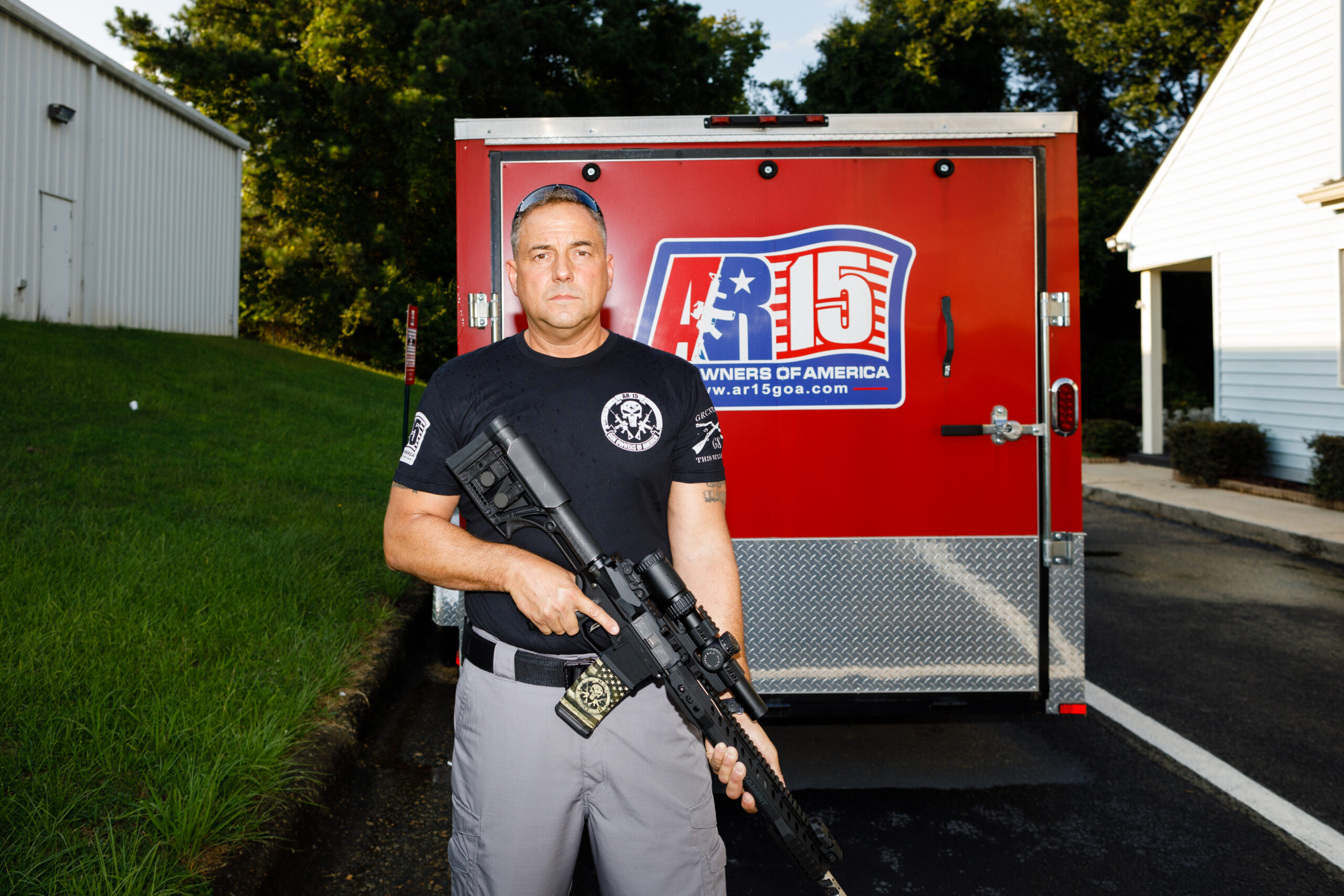
Portrait of Chris Waltz with his rifle in front of his trailer in the parking lot of his business AR-15 Gun Owners of America.
Cameron McWhirter, NF ’07, on the reporting behind the book “American Gun”
Zusha Elinson and I are reporters for The Wall Street Journal. He works out of San Francisco; I work out of Atlanta. We’ve covered a lot of mass shootings — horrific events that have been traumatizing American society with sickening regularity for years now. Everyone knows the places: Sandy Hook, San Bernardino, Las Vegas, Parkland, Dayton, Highland Park, Buffalo, Uvalde … on and on. Zusha and I found ourselves calling and texting each other after yet another shooting, “Was it an AR-15?” The answer often was yes.
In 2018, we published a page-one story about how gun companies had become reliant on AR-15 sales for profits, and how sales had spiked reliably in previous years after mass shootings.
But as we dove into that story, we found ourselves over-reporting — a reflexive habit among many journalists. We became fascinated with the saga of the gun, from its Cold War origins in the 1950s to its importance in our society today as the most popular — and most despised — rifle in America.
The tale starts with the self-taught, soft-spoken inventor, Eugene Stoner, who wanted to create a rifle for the U.S. military and its allies to combat the spread of communism. The gun was named AR-15 because it was the 15th weapon developed by ArmaLite, the small-arms developer where Stoner worked.
The saga includes the rifle’s convoluted adoption by the military involving bureaucratic intrigue, spies, and an Air Force general shooting watermelons. The military renamed its version the M16 for “model 16” and ramped up production as U.S. involvement in Vietnam increased. Notorious malfunctions of the rifle, caused by changes ordered by a Pentagon committee, caused troops to die in combat. The military tried to cover up the tragedy.
A semiautomatic version of Stoner’s rifle was sold to civilians but was unpopular for decades. However, extraordinary political battles in the 1990s helped propel AR-15 sales, and large gun makers in the 2000s marketed the rifle by appealing to buyers’ masculinity. A link developed between skyrocketing sales of the rifle and its increased use in mass shootings.
The AR-15 has become the leading symbol of our nation’s gun debate. Gun-rights advocates put its image on shirts, flags, bumper stickers, and even a brand of coffee. Gun-control advocates carry signs with an image of an AR-15 with a line through it. Its unique silhouette has become the focus of our never-ending argument about the role of firearms in our society.
Most AR-15 owners are responsible. A small number of people, however, bought their AR-15s to go to war with society through mass shootings. The same design innovations that were developed by the inventor in the 1950s to make the gun light and easy to shoot rapidly for soldiers in combat also made it easy for disturbed people — almost all of them young men with little prior knowledge of firearms — to wreak havoc everywhere people gather: schools, movie theaters, concerts, grocery stores, parades.
Covering these mass shootings is haunting. Journalists arrive to cover a tragedy and do their best, but after several days the reporters move on to the next story. After much heartache, you develop a compulsion to provide the public a clear and thorough understanding of how our country got to this place.
Zusha and I wanted to tell one important part of why these shootings were happening. We set out in 2019 to research and write “American Gun: The True Story of the AR-15.”
Over several years, we read thousands of documents at national archives, presidential libraries, universities, and research centers. We interviewed family and friends of the inventor, veterans, politicians, legislative advisors, lawyers, shooters, and, most importantly, victims of mass shootings. The result is a book about war, politics, invention, technology, society, and trauma — it’s American history for the last six decades told through a single object: the AR-15.
The result — the first social history of this gun and its impact on our country — was hard work, much harder than writing a single news story. The goal, however, was the same: to give readers a deeper understanding of this complicated world and its challenges.


